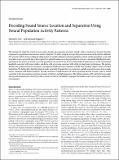| dc.contributor.author | Day, Mitchell L. | |
| dc.contributor.author | Delgutte, Bertrand | |
| dc.date.accessioned | 2014-09-02T17:49:20Z | |
| dc.date.available | 2014-09-02T17:49:20Z | |
| dc.date.issued | 2013-10 | |
| dc.date.submitted | 2013-07 | |
| dc.identifier.issn | 0270-6474 | |
| dc.identifier.issn | 1529-2401 | |
| dc.identifier.uri | http://hdl.handle.net/1721.1/89135 | |
| dc.description.abstract | The strategies by which the central nervous system decodes the properties of sensory stimuli, such as sound source location, from the responses of a population of neurons are a matter of debate. We show, using the average firing rates of neurons in the inferior colliculus (IC) of awake rabbits, that prevailing decoding models of sound localization (summed population activity and the population vector) fail to localize sources accurately due to heterogeneity in azimuth tuning across the population. In contrast, a maximum-likelihood decoder operating on the pattern of activity across the population of neurons in one IC accurately localized sound sources in the contralateral hemifield, consistent with lesion studies, and did so with a precision consistent with rabbit psychophysical performance. The pattern decoder also predicts behavior in response to incongruent localization cues consistent with the long-standing “duplex” theory of sound localization. We further show that the pattern decoder accurately distinguishes two concurrent, spatially separated sources from a single source, consistent with human behavior. Decoder detection of small amounts of source separation directly in front is due to neural sensitivity to the interaural decorrelation of sound, at both low and high frequencies. The distinct patterns of IC activity between single and separated sound sources thereby provide a neural correlate for the ability to segregate and localize sources in everyday, multisource environments. | en_US |
| dc.description.sponsorship | National Institute on Deafness and Other Communication Disorders (U.S.) (Grant R01 DC002258) | en_US |
| dc.description.sponsorship | National Institute on Deafness and Other Communication Disorders (U.S.) (Grant P30 DC005209) | en_US |
| dc.language.iso | en_US | |
| dc.publisher | Society for Neuroscience | en_US |
| dc.relation.isversionof | http://dx.doi.org/10.1523/jneurosci.2034-13.2013 | en_US |
| dc.rights | Article is made available in accordance with the publisher's policy and may be subject to US copyright law. Please refer to the publisher's site for terms of use. | en_US |
| dc.source | Society for Neuroscience | en_US |
| dc.title | Decoding Sound Source Location and Separation Using Neural Population Activity Patterns | en_US |
| dc.type | Article | en_US |
| dc.identifier.citation | Day, M. L., and B. Delgutte. “Decoding Sound Source Location and Separation Using Neural Population Activity Patterns.” Journal of Neuroscience 33, no. 40 (October 2, 2013): 15837–15847. | en_US |
| dc.contributor.department | Massachusetts Institute of Technology. Research Laboratory of Electronics | en_US |
| dc.contributor.mitauthor | Delgutte, Bertrand | en_US |
| dc.relation.journal | Journal of Neuroscience | en_US |
| dc.eprint.version | Final published version | en_US |
| dc.type.uri | http://purl.org/eprint/type/JournalArticle | en_US |
| eprint.status | http://purl.org/eprint/status/PeerReviewed | en_US |
| dspace.orderedauthors | Day, M. L.; Delgutte, B. | en_US |
| dc.identifier.orcid | https://orcid.org/0000-0003-1349-9608 | |
| mit.license | PUBLISHER_POLICY | en_US |
| mit.metadata.status | Complete | |
